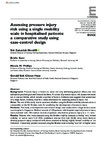Assessing pressure injury risk using a single mobility scale in hospitalised patients: a comparative study using case-control design
Date
2018-08Author
Subject
Metadata
Show full item recordAbstract
<jats:sec><jats:title>Background</jats:title><jats:p> Pressure injury is known to cause not only debilitating physical effects, but also substantial psychological and financial burdens. A variety of pressure injury risk assessment tools are in use worldwide, which include a number of factors. Evidence now suggests that assessment of a single factor, mobility, may be a viable alternative for assessing pressure injury risk. </jats:p></jats:sec><jats:sec><jats:title>Aims</jats:title><jats:p> The aim of this study was to ascertain whether using the Braden mobility subscale alone is comparable to the full Braden scale for predicting the development of pressure injury. </jats:p></jats:sec><jats:sec><jats:title>Methods</jats:title><jats:p> This study, a retrospective case-control design, was conducted in a large tertiary acute care hospital in Singapore. Medical records of 100 patients with hospital-acquired pressure injury were matched with 100 medical records of patients who had no pressure injury at a 1:1 ratio. </jats:p></jats:sec><jats:sec><jats:title>Results</jats:title><jats:p> Patients who were assessed using the Braden mobility subscale as having ‘very limited mobility’ or worse were 5.23 (95% confidence interval (CI) 2.66–10.20) times more likely to develop pressure injury compared with those assessed as having ‘slightly limited’ mobility or ‘no limitation’. Conversely, patients assessed using the Braden scale as having ‘low risk’ or higher were 3.35 (95% CI 1.77–6.33) times more likely to develop pressure injury compared with those assessed as ‘no risk’. Using full model logistic regression analysis, the Braden mobility subscale was the only factor that was a significant predictor of pressure injury and it remained significant when analysed for the most parsimonious model using backward logistic regression. </jats:p></jats:sec><jats:sec><jats:title>Conclusions</jats:title><jats:p> These findings provide the empirical evidence that using the Braden mobility subscale alone as an assessment tool for predicting pressure injury development is comparable to using the full Braden scale. Use of this single factor would simplify pressure injury risk assessment and support its use within busy clinical settings. </jats:p></jats:sec>
Collections
Publisher
Place of Publication
Journal
Volume
Issue
Pagination
Author URL
Recommended, similar items
The following license files are associated with this item:


